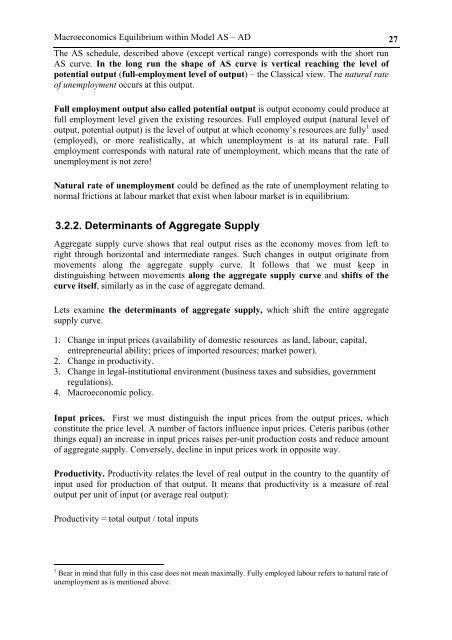MacroeconomicsI_working_version (1)
You also want an ePaper? Increase the reach of your titles
YUMPU automatically turns print PDFs into web optimized ePapers that Google loves.
Macroeconomics Equilibrium within Model AS – AD 27<br />
The AS schedule, described above (except vertical range) corresponds with the short run<br />
AS curve. In the long run the shape of AS curve is vertical reaching the level of<br />
potential output (full-employment level of output) – the Classical view. The natural rate<br />
of unemployment occurs at this output.<br />
Full employment output also called potential output is output economy could produce at<br />
full employment level given the existing resources. Full employed output (natural level of<br />
output, potential output) is the level of output at which economy’s resources are fully 1 used<br />
(employed), or more realistically, at which unemployment is at its natural rate. Full<br />
employment corresponds with natural rate of unemployment, which means that the rate of<br />
unemployment is not zero!<br />
Natural rate of unemployment could be defined as the rate of unemployment relating to<br />
normal frictions at labour market that exist when labour market is in equilibrium.<br />
3.2.2. Determinants of Aggregate Supply<br />
Aggregate supply curve shows that real output rises as the economy moves from left to<br />
right through horizontal and intermediate ranges. Such changes in output originate from<br />
movements along the aggregate supply curve. It follows that we must keep in<br />
distinguishing between movements along the aggregate supply curve and shifts of the<br />
curve itself, similarly as in the case of aggregate demand.<br />
Lets examine the determinants of aggregate supply, which shift the entire aggregate<br />
supply curve.<br />
1. Change in input prices (availability of domestic resources as land, labour, capital,<br />
entrepreneurial ability; prices of imported resources; market power).<br />
2. Change in productivity.<br />
3. Change in legal-institutional environment (business taxes and subsidies, government<br />
regulations).<br />
4. Macroeconomic policy.<br />
Input prices. First we must distinguish the input prices from the output prices, which<br />
constitute the price level. A number of factors influence input prices. Ceteris paribus (other<br />
things equal) an increase in input prices raises per-unit production costs and reduce amount<br />
of aggregate supply. Conversely, decline in input prices work in opposite way.<br />
Productivity. Productivity relates the level of real output in the country to the quantity of<br />
input used for production of that output. It means that productivity is a measure of real<br />
output per unit of input (or average real output):<br />
Productivity = total output / total inputs<br />
1 Bear in mind that fully in this case does not mean maximally. Fully employed labour refers to natural rate of<br />
unemployment as is mentioned above.




